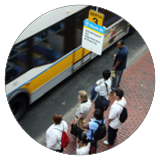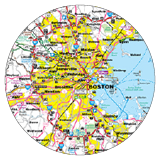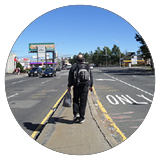 The Boston Region MPO (MPO) recently created a Park-and-Ride dashboard to showcase parking use and capacity data at all MBTA stations. Many MBTA stations, which include regional rail and rapid transit, have park-and-ride lots that people traveling to work use every day. Park-and-ride lots can be critical in helping people who do not live within walking distance of a station to access public transit. Since 2000, the MPO has periodically collected parking data, both of personal vehicle and bike, at every parking lot near MBTA stations. This includes those owned by the MBTA, owned privately, and owned by the municipality the station is located in. The data not only helps inform the public about parking information at MBTA stations, but also provides planners and engineers insight on where to invest in transportation infrastructure to support people taking transit.
The Boston Region MPO (MPO) recently created a Park-and-Ride dashboard to showcase parking use and capacity data at all MBTA stations. Many MBTA stations, which include regional rail and rapid transit, have park-and-ride lots that people traveling to work use every day. Park-and-ride lots can be critical in helping people who do not live within walking distance of a station to access public transit. Since 2000, the MPO has periodically collected parking data, both of personal vehicle and bike, at every parking lot near MBTA stations. This includes those owned by the MBTA, owned privately, and owned by the municipality the station is located in. The data not only helps inform the public about parking information at MBTA stations, but also provides planners and engineers insight on where to invest in transportation infrastructure to support people taking transit.
Blog - Articles tagged as studies

In the last year, increased attention to systemic racism has deepened the mainstream conversation about transportation equity. Many Black transportation planners have pushed the field to recognize that emphasizing enforcement in Complete Streets or Vision Zero paradigms can put people of color at risk of violence. Similarly, the COVID-19 pandemic has laid bare the intersection of systemic health inequality and transportation planning. The incidence of chronic respiratory disease in communities of color, exposure to harmful emissions, and high rates of COVID infection and death are all intertwined legacies of highway-focused planning in the United States and the Boston region.
Increased demand on limited curbside space by a range of users, from ride-hailing vehicles to delivery trucks, micromobility services, and more, has exacerbated congestion and made it difficult for officials to balance multimodal needs for safe and efficient curbside access.
 A recent study conducted by the Boston Region Metropolitan Planning Organization (MPO) found that a substantial number of Boston region workers reverse commute, but serving these trips by transit remains challenging because of entrenched land use patterns and the structure of transit, walking, and biking networks.Reverse commuters are residents of the core of a major urban area, such as Boston, who travel to and from work in the suburbs. In recent years, this phenomenon has become a major point of interest in media and public policy circles. The MPO study sought to better understand how many reverse-commute trips occur in the region so planners can develop strategies for improving these trips.
A recent study conducted by the Boston Region Metropolitan Planning Organization (MPO) found that a substantial number of Boston region workers reverse commute, but serving these trips by transit remains challenging because of entrenched land use patterns and the structure of transit, walking, and biking networks.Reverse commuters are residents of the core of a major urban area, such as Boston, who travel to and from work in the suburbs. In recent years, this phenomenon has become a major point of interest in media and public policy circles. The MPO study sought to better understand how many reverse-commute trips occur in the region so planners can develop strategies for improving these trips.
Large US cities are notorious for traffic congestion, and Boston is no exception. But not all congestion is the same. A bottleneck (or choke point) is different from a traffic jam, for example. Unlike congestion caused simply by heavy traffic volumes, a bottleneck is a recurring disruption of traffic at the same location in a roadway, which is usually caused by a specific physical condition—such as, the road design, abrupt changes in alignment, lane drops, merges and diverges, badly timed traffic lights, sharp curves; or other physical constraints that can make a roadway unable to handle the volume of traffic it receives...

On June 7, following a four-week pilot, the City of Boston announced the permanent installation of a bus lane on Washington Street between Roslindale Square and the Forest Hills MBTA station. This corridor was identified as a candidate for a bus lane through MPO staff work, which examined corridors in the Boston region where buses are routinely delayed in traffic.

The topic of long trips to work has been of considerable interest to the popular media recently. Since July 2017, the New York Times has published two major stories about people with long commutes in the New York City area and the San Francisco Bay Area. Here in Massachusetts, a Pew Charitable Trusts report released in June claimed that the population of “supercommuters” had grown by 45.4 percent from 2010 through 2015—the third-most of any state in the country...

A new study released by the Boston Region Metropolitan Planning Organization (MPO) offers solutions for creating a safe environment for pedestrians and bicyclists in the North Shore’s Vinnin Square, a large commercial and residential district located primarily in Swampscott and a section of Salem...
During 2010 and 2011, more than 15,000 Massachusetts households agreed to participate in a travel survey...

At the October 6 meeting of the Boston Region MPO, board members voted to initiate a study to research ways to reduce wait times for bus passengers on corridors in which multiple bus routes operate, so-called “trunk sections” of the MBTA bus network.

The City of Lynn has plans to redevelop 305 acres of waterfront real estate to vitalize the underutilized shoreline of Lynn Harbor with residential and commercial developments, marinas, a seaside boardwalk, and public greenspace.
Article Search
Archive
Tags
